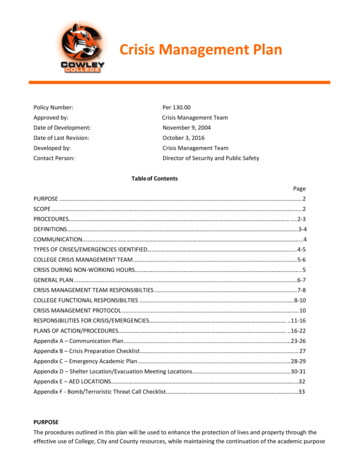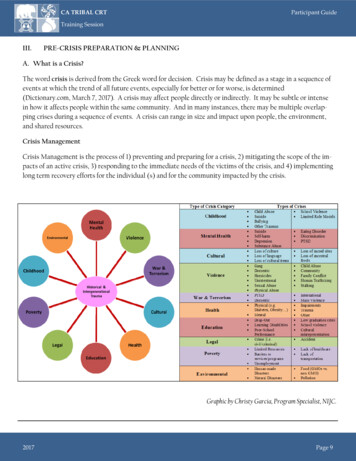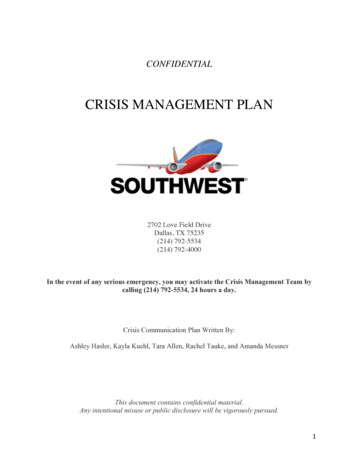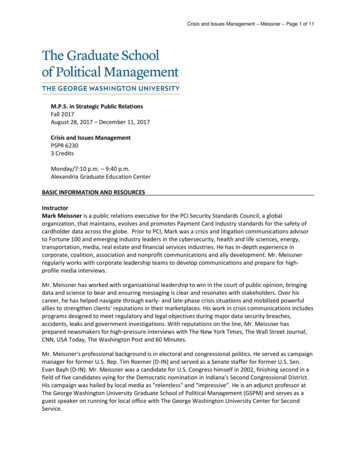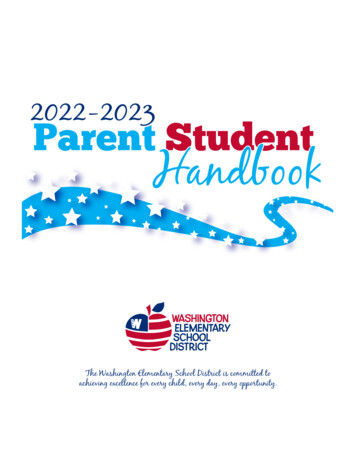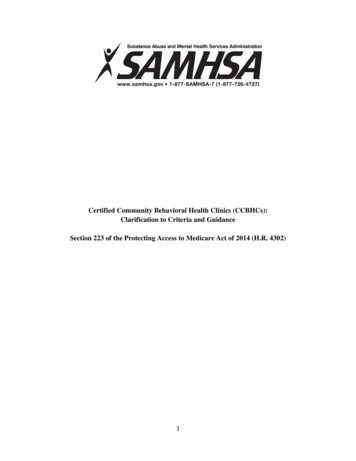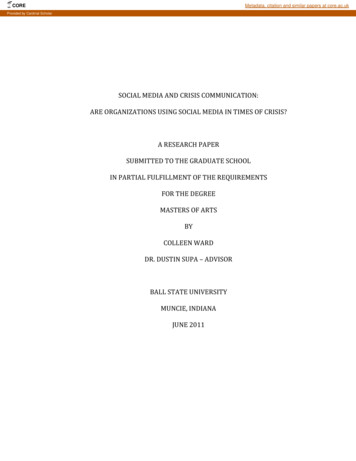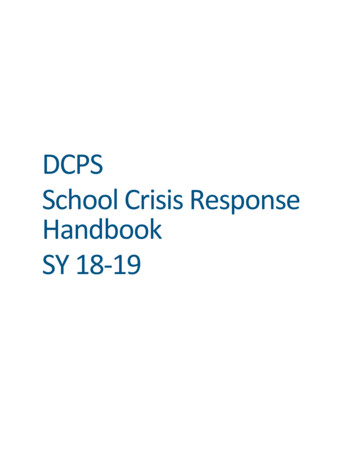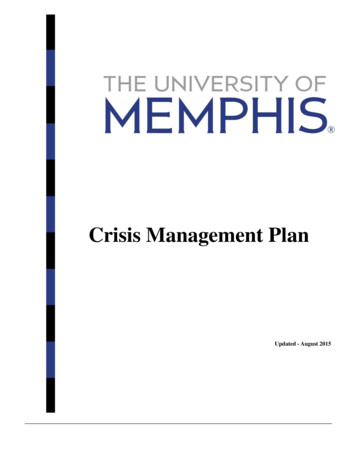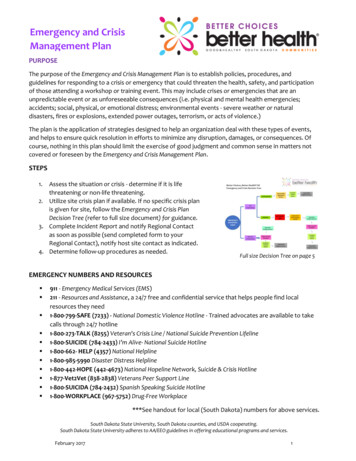
Transcription
Emergency and CrisisManagement PlanPURPOSEThe purpose of the Emergency and Crisis Management Plan is to establish policies, procedures, andguidelines for responding to a crisis or emergency that could threaten the health, safety, and participationof those attending a workshop or training event. This may include crises or emergencies that are anunpredictable event or as unforeseeable consequences (i.e. physical and mental health emergencies;accidents; social, physical, or emotional distress; environmental events - severe weather or naturaldisasters, fires or explosions, extended power outages, terrorism, or acts of violence.)The plan is the application of strategies designed to help an organization deal with these types of events,and helps to ensure quick resolution in efforts to minimize any disruption, damages, or consequences. Ofcourse, nothing in this plan should limit the exercise of good judgment and common sense in matters notcovered or foreseen by the Emergency and Crisis Management Plan.STEPS1.Assess the situation or crisis - determine if it is lifethreatening or non-life threatening.2. Utilize site crisis plan if available. If no specific crisis planis given for site, follow the Emergency and Crisis PlanDecision Tree (refer to full size document) for guidance.3. Complete Incident Report and notify Regional Contactas soon as possible (send completed form to yourRegional Contact), notify host site contact as indicated.4. Determine follow-up procedures as needed.Full size Decision Tree on page 5EMERGENCY NUMBERS AND RESOURCES 911 - Emergency Medical Services (EMS)211 - Resources and Assistance, a 24/7 free and confidential service that helps people find localresources they need1-800-799-SAFE (7233) - National Domestic Violence Hotline - Trained advocates are available to takecalls through 24/7 hotline1-800-273-TALK (8255) Veteran's Crisis Line / National Suicide Prevention Lifeline1-800-SUICIDE (784-2433) I’m Alive- National Suicide Hotline1-800-662- HELP (4357) National Helpline1-800-985-5990 Disaster Distress Helpline1-800-442-HOPE (442-4673) National Hopeline Network, Suicide & Crisis Hotline1-877-Vet2Vet (838-2838) Veterans Peer Support Line1-800-SUICIDA (784-2432) Spanish Speaking Suicide Hotline1-800-WORKPLACE (967-5752) Drug-Free Workplace***See handout for local (South Dakota) numbers for above services.South Dakota State University, South Dakota counties, and USDA cooperating.South Dakota State University adheres to AA/EEO guidelines in offering educational programs and services.February 20171
Emergency and CrisisManagement PlanEXAMPLESInjury Control (from Lay Leader Manual, Appendix V)If a workshop participant sustains an injury during the workshop: Determine if EMS activation is needed. Get the level of help needed to the person as fast as possibleand provide comfort to the individual as you wait for help to arrive. Continuation of the workshop depends on the severity of the injury. If the injury is major, you mostlikely would not continue. If the injury is minor, the co-leader could continue with the workshoponce help is obtained and refocus the needs of the group. If an accident occurs, follow the Emergency and Crisis Plan Decision Tree for proper handling andprotocol. It is better to be proactive- ensure room set up is arranged for easy access.Possible Environmental Emergencies (life-threatening) Natural disaster (i.e. tornado, blizzard, flood) Fire Carbon Monoxide Chemical Spill Safety ThreatPossible Personal Emergencies (life-threatening) Suspected Heart Attack or Stroke Loss of Consciousness (fainting) Seizure Anxiety Attack Suicidal personPossible Non-Life Threatening SituationsExamples:1.Susan, a CDSMP workshop participant, shares during her action plan how she was not able tocomplete her goals because of some family issues she experienced during the week. After the LayLeader asked a few more questions, Susan started crying and expressing concern for her safetybecause of physical abuse in her home. The Lay Leader expressed empathy and concern for Susan’ssafety and directed her to call the National Domestic Violence Hotline (from their list of resources)and asked if she had any other family that she could stay with in the meantime.2. Zack, a CDSMP workshop participant, always shares with the group during a brainstorm activityhow drinking and alcohol are his top ways to cope with problems, distress, and any personal issuehe is dealing with. After the second session, the Lay Leader could tell his comments were starting tomake some of the other class participants feel uncomfortable. Therefore, the Lay Leader pulledZack aside after the second session to talk to him about his comments, how his comments arechanging the comfort and atmosphere for others in the class, and shared with him concern for hiswell-being. The Lay Leader then shared with Zack contact information for the Substance Abuse andMental Health Services Administration and encouraged him to reach out to them.South Dakota State University, South Dakota counties, and USDA cooperating.South Dakota State University adheres to AA/EEO guidelines in offering educational programs and services.February 20172
Emergency and CrisisManagement PlanEMERGENCY CONTACT LISTHost Site Emergency Contact- See Workshop Location/Implementation Site Agreement (front of Manual)Regional XXXTribalPhoneEmailXXX - Regional Contact ManagerXXX - Program AssociateXXX - Program CoordinatorSouth Dakota State University, South Dakota counties, and USDA cooperating.South Dakota State University adheres to AA/EEO guidelines in offering educational programs and services.February 20173
Emergency and CrisisManagement PlanINCIDENT REPORTFor Better Choices, Better Health SD Workshop or TrainingDate of Incident: / /Workshop Location:Workshop Start Date: / /Time of Incident : am pmRoom Number:Workshop Time : am pmSponsoring Agency:Reporting Facilitator:Name: Phone Number ()-)-Other Method of ContactCo – Facilitator:Name: Phone Number (Other Method of ContactDetailed description of incident and actions takenWitness(s)Name PhoneName PhoneSouth Dakota State University, South Dakota counties, and USDA cooperating.South Dakota State University adheres to AA/EEO guidelines in offering educational programs and services.February 20174
Emergency and CrisisManagement PlanSouth Dakota State University, South Dakota counties, and USDA cooperating.South Dakota State University adheres to AA/EEO guidelines in offering educational programs and services.February 20175
1. Assess the situation or crisis - determine if it is life threatening or non-life threatening. 2. Utilize site crisis plan if available. If no specific crisis plan is given for site, follow the Emergency and Crisis Plan Decision Tree (refer to full size document) for guidance. 3. Complete Incident Report and notify Regional Contact
